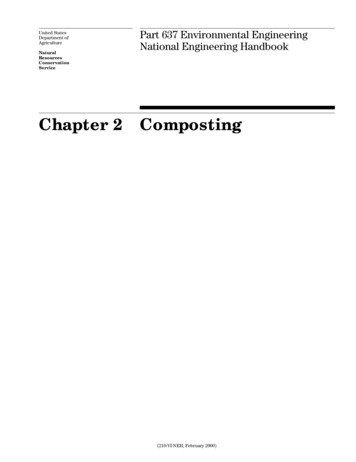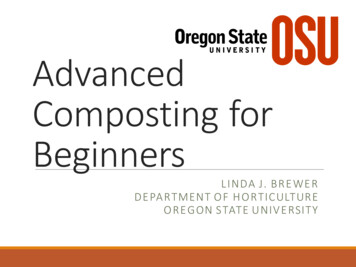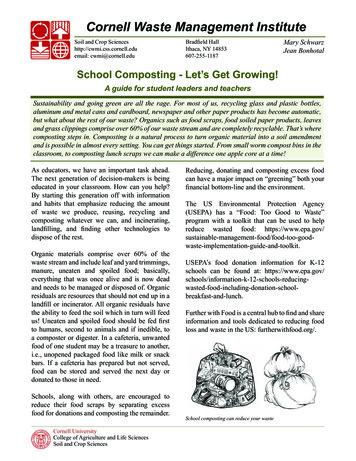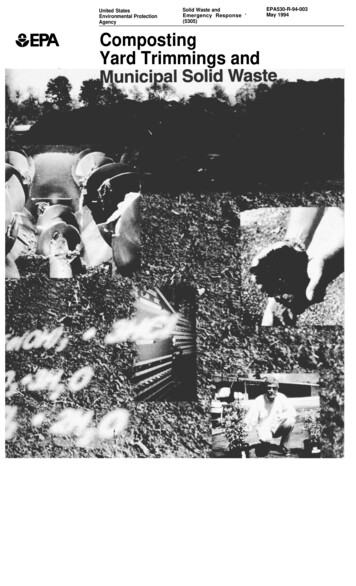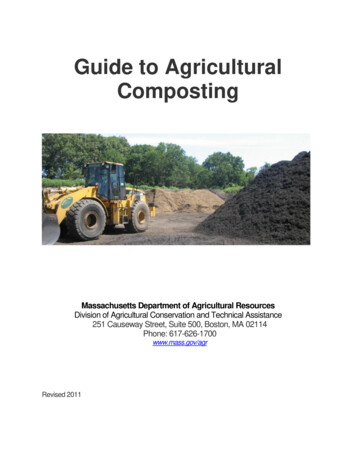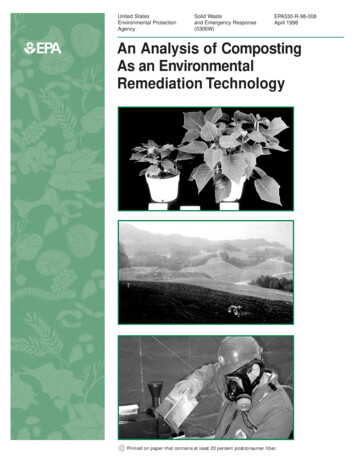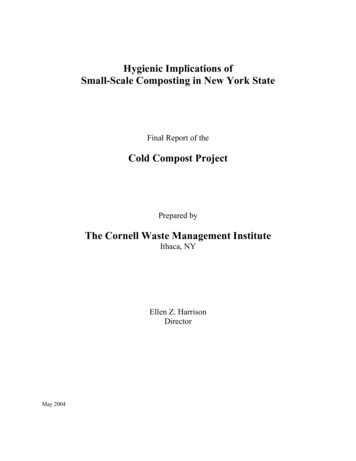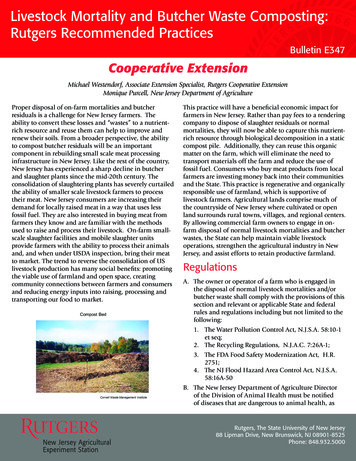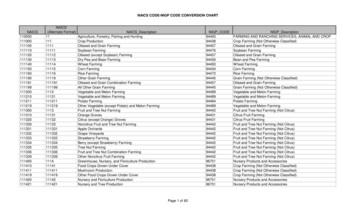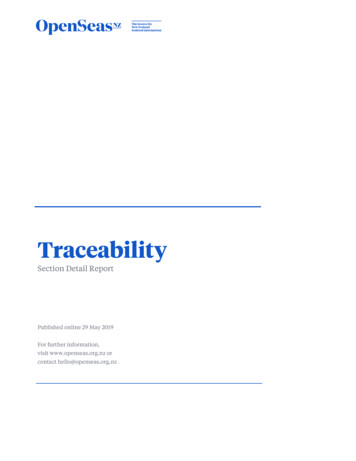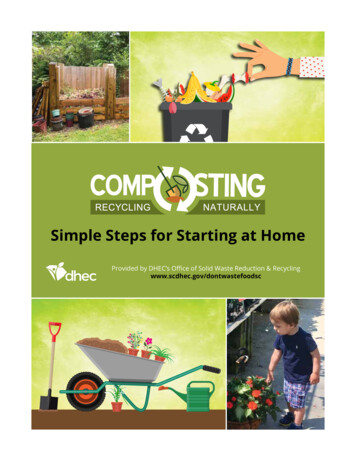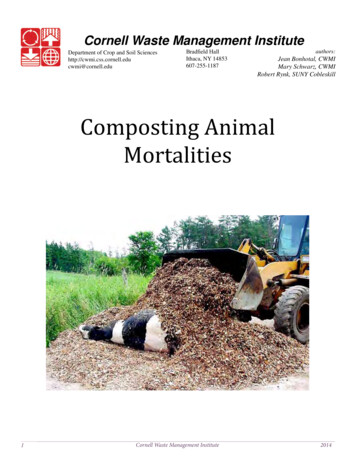
Transcription
Composting Animal MortalitiesCornell Waste Management InstituteDepartment of Crop and Soil uBradfield HallIthaca, NY 14853607-255-1187authors:Jean Bonhotal, CWMIMary Schwarz, CWMIRobert Rynk, SUNY CobleskillComposting AnimalMortalitiesComposting Animal1Cornell Waste Management Institute2014
Composting Animal MortalitiesTable of Contents1 Introduction.32 Mortality Composting -- Not Your Typical Compost .52.1 Overview.52.2 Differences due to Scale and Animal Size .63 Feedstock Characteristics and Requirements.73.1 Carcass Characteristics .73.2 Preprocessing Carcasses .83.3 Amendments – Carbon Sources/ Bulking Agents.84 Siting and Sizing the Mortality Composting Operation .104.1 Siting considerations.104.2 Sizing Guidelines .115 Mortality Composting Methods and Procedures .155.1 Passively Aerated Static Piles/Windrows and Bins .155.2 Turned Windrow Composting.175.3 Forced Aeration.185.4 In-Vessel Composting .185.5 Bins .185.6 Mini-Composters .195.7 Rotating Drums.196 Monitoring Compost Piles or Windrows .207 Pathogen Control .207.1 Special Considerations.218 References Cited and Suggested Readings .22List of FiguresFigure 6-1. Whale bone remains following composting.4Figure 6-2. Enveloping a carcass with wood chips.6Figure 6-3. Compost pile opened after 4 months. .7Figure 6-4. Layering animal mortalities .7Figure 6-5. The functions of amendments in mortality composting.9Figure 6-6a. Results for Bessy’s Dairy using Spartan ATC System Planner .12Figure 6-6b. Results for Bessy’s Dairy using Co-Composter.13Figure 6-6c. Steps used to determine windrow size .14Figure 6-6d. Results for Bessy’s Dairy using equations .14Figure 6-7. In well-built piles with chunky carbon bases.15Figure 6-8. Static windrow composting.16Figure 6-9. Deer carcasses placed on the base layer.16Figure 6-10. NYS Department of Transportation applying road kill compost along highway.17Figure 6-11. Example of a wooden bin used for poultry .18Figure 6-12. Wire bin mini-composter.19Figure 6-13. Rotating drum for carcass composting.20List of TablesTable 6-1. On-farm mortality rates and average weights.8Table 6-2. Attributes of common on-farm composting materials .102014Cornell Waste Management Institute2
Composting Animal Mortalitiesprohibits composting of unprocessed mortalities.According to the Department for Environment, Food andDisposing of animal mortalities is a natural part of Rural Affairs in the UK, deads can be composted if they areanimal agriculture; however, it is not limited to on- pressure-rendered and butcher/slaughter house waste canfarm applications. Meat processors and distributors, be composted without any pre-treatment (https://www.the fishing industry, public works and environmental gov.uk/dealing-with-animal-by-products). The argumentmanagers also routinely need to dispose of carcasses is that the safety of mortality composting is unprovenor other animal by-products. As traditional methods of for prion diseases and some other animal diseases. Thedisposal – burial, incineration and rendering – have lost concern is that handling the carcasses and distributing thefavor or increased in cost, farmers, butchers and public compost might contribute to the spread of diseases likeworks departments are finding it increasingly difficult Bovine Spongioform Encephalopathy (BSE or “mad cowto find biosecure, inexpensive and environmentally safe disease”). Even where mortality composting is accepted,disposal. Composting is providing another option, at least BSE and other prion diseases remain a concern because ofthe prion’s resistance to destructionin North America.Prion Diseasesby heat (see sidebar).Carcasses from routine livestock Bovine Spongiform Encephalopathyand poultry mortalities, animals (BSE or mad cow disease), Chronic In cases where animals arekilled in catastrophic events (e.g. Wasting Disease (CWD) in deer and elk suspected of, or confirmed withdisease outbreaks, storms), road and Scrapie in sheep and goats are all prion diseases, work with state andkill, beached sea mammals and diseases called Transmissible Spongiform federal veterinarians. CompostingEncephalopathies (TSEs) caused by might be completed in a containedmeat and fish from processingprions. A prion is a protein chain that hasoperations (e.g. butchers) may become mis-folded and can infect and area to reduce volume and moisture.all be composted. The common replace normal protein chains in the brain Then the resulting residuals, chipsfactor among these applications of an animal. Transmission among same and bones could be burned in ais that they involve concentrated and different species is not completely high temperature incinerator toamounts of animal tissue, with understood with prion diseases. Disabling destroy the prion. Burning wholehigh proportions of protein and this protein chain is difficult: it takes animals at high temperatures ismoisture. Typically, organs, flesh, exposure to heat of 1800-2000 F or alkaline energy intensive and it is difficultdigestion. Neither of these conditions to achieve high temperatureshides, feathers and bones may beoccurs in the compost process. There isincluded. Handling and composting some evidence that certain enzymes and throughout large carcasses.these materials demands care and competition from organisms might have The scarcity and cost of renderingspecial practices to accommodate an effect. Research is ongoing to further is probably the biggest factor in thetheir challenging properties and explore prion destruction.growing reliance on composting.to control disease, odors, flies,While renderers once paid farmersscavengers and leachate. In these applications, the for animals, in many locations, the farms are now beingcomposting system tends to be dedicated to treating or charged for the service, or the service is unavailable.managing the carcasses; the production of compost is Many rendering operations have been curtailed by diseaseusually incidental.concerns that have caused fluctuation in prices for hides,Composting animal mortalities is rapidly spreading in the tallow, meat, bone meal and the other useful commoditiesUnited States and Canada. Regulations concerning carcass derived from animal carcasses. Some butchers processdisposal in the U.S. vary. Because of the instability in the animal species (e.g. goats, sheep, ostrich, deer and wildU.S. rendering industry many states are now addressing hog) that are not acceptable in the rendering stream sothis in regulations1. In the European Union, regulation they are limited in their disposal.1 Introduction1 Forty-three states have regulations in place listing compostingComposting provides an alternative to traditional carcassas an acceptable method. California allows composting ofdisposal as it can be less expensive, is self-sufficientnon-mammals only. AK, CT, NV, NH, NJ, WV and WI do notlist composting as a method. AK, WV and WI list every otherNH lists burial only and NJ does not list any methods exceptmethod but composting. CT and NV list only burial and burning.rendering for hogs that die of cholera.CornellWasteManagementInstitute20143
Composting Animal Mortalitiessite by farm staff using theirown machinery. It requires nooutside personnel or vehiclesthat may be carrying pathogensfrom other farms. Deadanimals can be isolated andincorporated in the compostpile promptly, rather thansitting on the ground waitingfor pick up from renderingor landfill service providersor for the accumulation ofenough material to fire up anincinerator.Figure 6-1. Whale bone remains following compostingand is biosecure. The temperatures achieved throughthe composting process may eliminate or greatly reducepathogens, hindering the spread of disease. Researchcontinues to demonstrate effective destruction of nearlyall livestock diseases of concern. Properly compostedmaterial is environmentally safe and a useful soilamendment.Composting also provides farms the advantage ofbiosecurity. Biosecurity refers to possible introductionof potentially infectious organisms (pathogens) fromoutside sources, such as wild animals, and peopleand vehicles that have traveled from other farms andfacilities. Normally, composting is accomplished on-Whenconsideringthedisposal of animal carcassesand by-products, one shouldremember that composting isnot necessarily the most desirable method. All thingsequal, preference should be given to processes thatrecover non-diseased animal by-products for food or feedfor animals and render them into commercial products.As an example, the raw and basted dog bone business isthriving in the U.S. and may offer outlets of local marketsto farmers and butchers.This guide provides an overview of composting animalsand animal tissue in order to familiarize the reader withthe associated applications, requirements, methods andmanagement practices. For readers who wish to pursuethis composting option, numerous publications, videoprograms and web sites are available that provide manydetails, such as state regulations, step-by-step proceduresA Whale of a Tale!In 1999, a Northern Right Whale in the North Atlantic became severely entangled in fishing equipment. About six monthslater the whale was found dead off the coast of New Jersey. The US Coast Guard hauled the 30,000-pound whale to shore.Since there are only approximately 300 Northern Right Whales left, a call went out to museums to see if there was interestto preserve this whale in some way. The Paleontological Research Institute (PRI) in Ithaca, NY requested the whalecarcass, primarily to recover the skeleton.In New Jersey, some of the flesh and blubber was cut off the carcass and it was hauled on a flat-bed truck to Ithaca. BehindPRI, next to the Cayuga Medical Center, the whale was laid in a large bed of horse manure and completely covered andleft to compost in a large pile. The pile was left for six months (October-April) and gently uncovered so the bones couldbe tagged and turned by hand. The bones, bits of flesh and skin were again covered and left until October (Figure 6-1).With many volunteers, the bones were cleaned and weighed and ready to be assembled. It is interesting to note that inone year the bones actually showed signs of pitting and degradation, suggesting that, for preservation purposes, the bonescould have been removed from the pile sooner. The whale skeleton that was composted on their site is on display at thePRI in Ithaca2014Cornell Waste Management Institute4
Composting Animal Mortalitiesfor various applications and instructions for buildingcomposting windrows and structures. For furtherguidance, see suggested reading and references at theend.2 Mortality Composting -- Not YourTypical Compost2.1 OverviewTo state it bluntly, mortality composting deals withanimal flesh – whole dead animal carcasses and/or animalparts such as afterbirth, offal, organs, blood, fish wastes,bones, feathers, hides and raw meat from butchers2.Composting this flesh waste differs from other categoriesof composting. While most of the fundamental principlesare the same, specific practices evolved for compostingmortalities for two reasons: First, the production ofsalable compost is usually not a primary goal. Second,there is a higher concern for disease, hygiene, odors, flies,vermin and scavengers.Farm mortalities and similar materials are compostedby a variety of methods. Nearly all methods sharedistinct procedures that isolate the carcasses fromthe environment until they decompose. Compostingcarcasses in vessels provides some of that isolation, butmaterial needs to be fairly uniform. Grinding carcassesmakes the process more like conventional compostingand also makes forced aeration practical but adds an extrastep and requires additional health and safety precautions.Composting whole carcasses in passively aerated piles/bins is the most common approach and receives the mostemphasis here.The first stage of animal mortality composting in passivelyaerated piles can be described as above ground disposalor entombment within an organic biofilter. With a fewexceptions, carcasses are not mixed with other feedstocksbut rather they are layered and/or surrounded by otherfeedstocks (Figure 6-2). Those other feedstocks includedry, carbon-rich and moisture-absorbing amendments(e.g. straw, sawdust, wood chips, recycled compost)and may also include other ingredients like poultry litterand manure. Composting is more efficient and effectiveif air can flow through the amendments to keep the pileaerobic. Simply put, an optimum habitat needs to becreated for microorganisms to thrive and digest flesh.A mix of chunky and fine carbon-rich material can beused. In dry climatic conditions, water may be added tothe amendments during pile construction. For weeks tomonths, the carcasses decompose undisturbed within anenvelope of carbonaceous amendments. In this stage, theflesh substantially decomposes while the temperaturesincrease to and remain at thermophilic levels gretlyreducing pathogens.In the first stage of composting, the carcasses are dense,wet and have a low C:N ratio, while the surroundingamendments are relatively dry, porous and typically havea high C:N ratio. At different times in the process, thereare aerobic and anaerobic zones in the pile, producingliquids and gases that migrate into, and are absorbedwithin, the envelope of amendments. The liquids andgases continue to decompose along with the amendments.The surrounding media serves as a biofilter, adsorbingvolatile organic compounds and trapping leachate andodors (Figure 6-3). The pile can be left intact for curingfor 6-9 months or it can be turned or combined with otherMass Casualty / Emergency ResponseDeath of large numbers of animals can occur for many reasons including fire, lightning, barn collapse, powerinterruptions, disease outbreaks, floods, fish kills and marine mammal beaching. Composting can provide a timelysolution for any amount of animals if space and bulking materials are available. Finding enough appropriate carbonsources can be tough in emergency situations, so those planning should have a list of possible sources (see CompostBulking Materials fact sheet #5). If there is a disease issue where typical thermophilic temperatures may not providesufficient disease or pathogen control, additional measures can be taken. Organization is the most important factorin responding to such an emergency. Plans should be developed with multiple disposal tools so that response timebe quick withinand effective.Forexample,of Agriculture in Maine has developed a plan for the2 willFor simplicity,this chapterthesematerialstheare needed.Activesludgecomposting is common in many areas and the productincluded in the terms carcass and mortalities unless otherwiseis available. They plan to lay the carcasses on a bed of active sludge compost and cover it, allowing the heat of thespecified.sludge compost to jump-start the mortality composting process.5Cornell Waste Management Institute2014
Composting Animal Mortalitiescarcass piles. The medium (bones and still availablecarbon) can be reused for another carcass.If turned, the remains of the carcasses, plus the liquidsand gasses released, are blended with the surroundingfeedstocks and composting continues more uniformly,more like conventional composting. Temperaturesusually return to thermophilic levels for several weekslonger. Additional turnings may shorten the secondstage, depending on the management preferences andconditions. While one pile composts through the secondstage, another pile can be composted through the firststage.In practice, it is best not to rush the compost process.Composting a 1000-pound cow under good conditionsgenerally takes 3-4 months for the flesh to disappear; forsmall carcasses like birds and fish the flesh decomposesin 2-3 weeks. However, this time relates to just the firststage (thermophilic phase), as the compost itself doesnot reach adequate maturity for another 4-12 months inthe curing phase. The composting time for both phasesdepends on the size of the carcass.Even after the process is finished and the compost ismature, bones persist, (unless the animals are immatureor soft-boned). Clean bones can be recycled through theprocess. They add structure to pile and become brittlewith age. Feathers from poultry and wool from sheep takelonger to decompose than meat. Large chips, feathers andbones can be recycled as part of the media for future pilesor bins.2.2 Differences due to Scale andAnimal SizeProcedures for composting animal mortalities vary withthe size of the carcass and the scale of the task; that is, thenumber of carcasses handled at each loading. The mostcommon situation is composting of routine mortalities –the fraction of the flock or herd that periodically die ofnatural causes. Depending on the type of farm, and itssize, each loading can range from a single cattle carcassto several dozen fish or birds.The dimensions of individual piles and bins vary withthe animal species, size of the operation and equipmentused. Heights typically range from 4 to 6 ft. (1.2 to 1.8m), although heights of 8 ft. (2.4 m) are sometimes used.Some bins (e.g. mini-bins) for poultry and fish are only 3ft. (0.9 m) high. Freestanding piles and windrows tend tobe 10 to 16 ft. (3.0 m to 4.8 m) wide at the base. The widthof bins depends on the means of loading and unloading.They range from 3 ft. (0.9m) for mini-bins to upto 12 ft. 2.7 m) for largeoperations.Figure 6-2. Enveloping a carcass with wood chips2014Cornell Waste Management InstituteMortalitycompostingmethods evolved from thebasic passively aeratedpile or bin approachdeveloped for compostingpoultry mortalities. Withthat approach, a numberof carcasses are placed ina layer on a base of dryamendment and cappedwith more amendment.Layers are built upwardin succession until thepile or bin reaches itsdesired maximum height(Figure 6-4). Layeringpredominates with small6
Composting Animal MortalitiesWeights and mortality rates forvarious animal species are listed inTable 6-1.3 FeedstockCharacteristics andRequirements3.1 CarcassCharacteristicsThe primary feedstocks in mortalitycomposting are the animal carcassesor animal tissues separated froma carcass such as meat, offal andorgans. Carcasses include bones,feathers, hide and fur. The differentcomponents decompose at differentFigure 6-3. Compost pile opened after 4 months. Most of the soft tissue is gone,rates and to a varying extent. Bonesleaving some hide, hair and bones. The wood chips are dry on the outside havingare the most resistant and usuallyadsorbed and contained leachate and odors.pass through the composting processcarcasses (e.g. birds and fish) and moderate carcasses intact, though they become brittle. Feathers, hides, wool,(e.g. pigs, small deer and calves). However, a pile or bin animal hooves and poultry legs take longer to decomposecannot accommodate numerous layers of whole large than the soft tissue.carcasses, such as mature sows, cattle and horses. Largeranimals are typically composted in a pile, windrow or binwith only one or two layers. As more animals are added,additional piles are started or the pile is expanded inlength creating a windrow.While the various components of carcasses presentvarying characteristics, in general, animal carcassescan be considered sources of nitrogen and moisture.Most animal tissues, including feathers and fur, are aconcentrated source of protein with a relatively highnitrogen content. Cells of animal tissue hold a greatAs the size of the carcass increases, a greater volume ofamendment is required per unitcarcass. In addition, while smallcarcasses can be loaded by hand,a tractor or a loader is requiredto handle large animal carcasses.If carcasses are ground prior tocomposting, there is virtuallyno distinction between theprocedures for large and smallcarcasses as grinding permitsmore conventional compostingpractices to be followed.However, grinding animal fleshand bone is hard on equipmentand the people that are grinding.Figure 6-4. Layering animal mortalities7Cornell Waste Management Institute2014
Composting Animal Mortalitiesdeal of water, which is released as the cells break down.Depending on the animal and source, carcasses can alsoinclude appreciable amounts of fats, which are a richsource of carbon. While carbon and nitrogen ratios areimportant, if the animal carcass is managed whole theratio will not be in balance to start with. As the animaldecomposes the carcass and the carbon source slowlymix together with the ending C:N ratio of most typicalfinished composts.is a good practice to pierce the stomachs, especially therumen, of cattle and other ruminants to prevent bloatingand, possible explosion, from accumulating gases. Totalsize reduction like grinding or chipping will expedite theprocess but requires specialized equipment, as well asadditional worker health and safety requirements. It canbe messy and unsettling. Size reduction will also solveproblems with bones in the end-product and make theprocess and product less recognizable. Grinding allowsfor management of an evenly sized waste stream andwould be managed more like butcher waste.An important characteristic is the high potential fornuisance issues, something that can, and must be, keptin checked. Left exposed, carcasses attract scavenging3.3 Amendments – Carbon Sources/animals and insect pests including rodents, birds,Bulking Agentsdogs and flies. In addition, the wet and protein-richcomposition makes animal tissue prone to putrid odors. Mortality composting relies on other feedstocks, selectedThe proteins break down to produce ammonia and to make composting of the carcasses practical. Feedstocksodorous amines, especially at low C:N ratios and underanaerobic conditions. TheTable 6.1 - On-farm mortality rates and average weightsodors produced by aminesMortality rate (%)Average weight (lbs)eare exemplified by the names Speciesa4.9100of two particular amine Horse – FoalsAdult1.81200-1500compounds: putrescine and11.28Sheepb – Lambscadaverine. Both of theseAdult5.080-170foul-smellingcompounds6.5Dairy Cowsc – Still birthsoccur in decaying animalPre-wean7.890tissue. Animal fats and oilsHeifers1.8600contribute to the formationCows5.71400of volatile fatty acids, which Beef Cowsd – Pre-wean3.6600are also odorous. DistinctiveFeedlot1.5850features of animal mortality Poultrye – Laying hen144.0composting, such as thickBroiler breeding hen117.0covers of amendment andBroiler breeder pullet54.3restricted turning have beenCommercial egg pullet52.8Broiler54.5developed to control pests andRoaster88.0odors.Turkey hen616.0Turkey tom925.03.2 PreprocessingCarcassesAlthough any animal can becomposted whole with minimalprocessing,preprocessingmay speed up the process.Large swine carcasses areoften splayed under each legand from the neck down toopen up the stomach cavity. It2014Swinee – Still birthsFarrow to weanNurseryGrow/FinishBreeding herd0.1-110-152-52-82-62-31030160350USDA APHIS, 2007: Trends in Equine Mortality, 1998, 2005USDA APHIS, 2011: Sheep 2011cUSDA APHIS, 2007: DairydUSDA APHIS, 2008: BeefeRozeboom, et al., 2007abCornell Waste Management Institute8
Composting Animal Mortalitiesare commonly referred to as amendments because theyare added to complement a primary feedstock, in thiscase, animal carcasses. They may also be referred to asbulking agents and carbon sources. The carcasses arecommonly composted with a single amendment thatserves the purpose well, or well enough. In other cases, acombination of different amendments is used to improvethe characteristics of the media, or because a singleamendment is not available in sufficient quantity. Mostoften, the medium includes fresh amendments and/orsome of the compost recycled from previous batches.The amendments within the composting mediumserve several functions (Figure 6-5). They absorbmoisture, and trap and degrade volatile gases andodors from decomposing carcasses. Most importantly,the amendments provide carbon, structure, porosityfor air exchange and a barrier with the surroundingenvironment. Thus, good amendments have the followingcharacteristics: Relatively dry ( 50% moisture) Particles with some rigidity plus a large surfacearea High C:N ratio ( 40:1) with available forms ofcarbon Non attractive to pests Decompose well enough to produce usablecompost Low bulk density (porous)Wood chips, wood shavings, sawdust, chopped straw,recycled compost and poultry litter are the amendmentsmost often used for mortality composting. Table 6-2indicates their general characteristics. Other materialsthat have been used as amendments include horse stallbedding (with manure), feed refusal, old corn silage, oldhay, dry manure, peanut hulls, corn cobs, corn stalks,shredded paper products, shredded yard trimmings,bark, peat moss, active compost and mature compost.Shredding improves, and may be necessary for, feedstockwith large particles (e.g. straw, hay, corn stalks, cardboardand leaves). A one to two inch (2.5 to 5.1 cm) particle sizewith different size fines mixed in, works best. Passiveaeration will not be efficient with small particle sizes. Forexample, sawdust that is very fine without larger piecesmixed in, will absorb moisture, but then fill with waterand no longer provide aeration. The particle size of thebase material should promote aeration of piles and binsand also be thick enough to absorb the moisture generatedabove.When considering amendments, it should be rememberedthat, “All amendments are not created equal.” Forinstance, particle size makes a difference: wood chipsare larger and provide more porosity than shavings; andshavings provide more porosity than sawdust. In termsof degradability and the availability of carbon, sawdustwould be best of the three choices and wood chips, theworst. However, wood chips are preferable because theygive the pile the structure it needs to facilitate aeration.The condition of the amendment matters, perhaps morethan the type of material. The moisture content, particlesize, porosity, bulk density, C:N ratio and age can varyfor almost any type of amendment. Wet sawdust doesnot absorb moisture as well as dry wood chips. Maturecompost, aged manure and very old silage may notprovide enough carbon or energy to sustain heating whileCore Media: adsorbs gases andodors, separates carcassesand isolatesintermediatelayers, provides C,energy, mass andvolume, absorbs liquids.Cap or Cover: insulates andisolates, shedsprecipitation adsorbs gasesand odors, deters pestsBase: adsorbs liquids, allows air to enter.Figure 6-5.
Composting Animal Mortalities . Figure 6-1. Whale bone remains following composting . and is biosecure. The temperatures achieved through the composting process may eliminate or greatly reduce pathogens, hindering the spread of disease. Research continues to demonstrate effective destruction of nearly all livestock diseases of concern. Properly .
